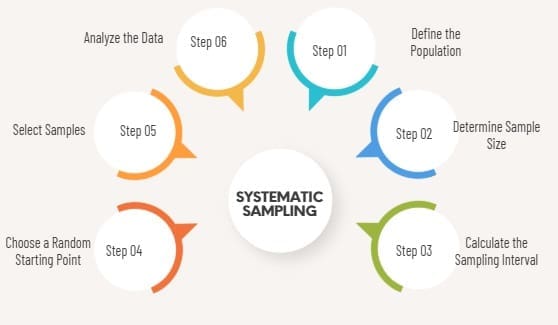Systematic sampling is a probability sampling method where researchers select every nth item from a population. This sampling technique creates a systematic pattern for choosing participants or data points. Unlike simple random sampling, systematic sampling follows a structured approach that ensures equal intervals between selections.
The systematic sampling definition involves dividing the total population by the desired sample size. This calculation determines the sampling interval, also called the skip interval. For example, if you need 100 participants from a population of 1,000, you would select every 10th person.
Table of contents
What is Systematic Sampling?
Systematic sampling is a probability sampling technique. It involves selecting every kth element from a list. The process starts with a random selection. Then, it follows a fixed interval. This interval, called the sampling interval, ensures uniformity.
For instance, imagine a list of 1000 customers. You want a sample of 100. Divide 1000 by 100 to get a sampling interval of 10. Start with a random number, say 5. Then, select every 10th customer (5, 15, 25, etc.). This is a systematic random sample.
This method is straightforward. It reduces bias compared to non-probability methods. It’s ideal for large populations. Researchers use it in surveys, quality control, and market research.
Public, Onsite, Virtual, and Online Six Sigma Certification Training!
- We are accredited by the IASSC.
- Live Public Training at 52 Sites.
- Live Virtual Training.
- Onsite Training (at your organization).
- Interactive Online (self-paced) training,
Example Calculation
Population size: 800 students
Desired sample: 80 students
Sampling interval: 800 ÷ 80 = 10 Random start: 4 (randomly chosen between 1-10)
Selected students: 4, 14, 24, 34, 44… up to 794
Basic Formula
k = N/n
Where:
- k = sampling interval
- N = population size
- n = desired sample size
Key Features of Systematic Sampling
- Structured Selection: Samples are chosen at regular intervals.
- Random Start: The first element is randomly selected.
- Efficiency: It’s faster than simple random sampling.
- Uniform Coverage: Ensures even distribution across the population.
Systematic Sampling vs. Other Sampling Methods
Systematic sampling differs from other techniques. Let’s compare it with cluster and stratified sampling.
Systematic Sampling vs. Cluster Sampling
Cluster sampling divides a population into groups. These groups, or clusters, are randomly selected. All elements within chosen clusters are studied. For example, a researcher might select entire schools as clusters. This differs from systematic sampling, which selects individuals at intervals.
Cluster sampling is useful for geographically spread populations. It reduces travel costs for researchers. However, it may introduce bias if clusters aren’t diverse. Systematic sampling, conversely, ensures even representation. It’s better for uniform populations.
Systematic Sampling vs. Stratified Sampling
Stratified sampling divides the population into subgroups. These subgroups, or strata, share similar characteristics. Random samples are taken from each stratum. For instance, a survey might group people by age. Then, it randomly selects from each age group.
Systematic sampling doesn’t use subgroups. It treats the population as a whole. Stratified sampling ensures representation of specific groups. Systematic sampling is simpler but may miss subgroup nuances.
Systematic Sampling vs. Simple Random Sampling
Simple random sampling selects elements purely by chance. Every individual has an equal chance of selection. Systematic sampling, however, uses a fixed interval. This makes it less random but more structured. Systematic sampling is faster for large datasets. Simple random sampling can be time-consuming.
Also Read: What is Random Sampling?
How to Conduct Systematic Sampling?

Conducting systematic sampling is straightforward. Follow these steps for accurate results.
Step 1: Define the Population
Identify the entire population to study. For example, a company’s employee list. Ensure the population is well-defined and accessible.
Step 2: Determine Sample Size
Decide how many samples you need. A larger sample increases accuracy. Use statistical tools to calculate the ideal size.
Step 3: Calculate the Sampling Interval
Divide the population size by the sample size. This gives the sampling interval (k). For a population of 500 and a sample of 50, k = 10.
Step 4: Choose a Random Starting Point
Select a random number between 1 and k. This ensures the process remains unbiased. Use a random number generator for fairness.
Step 5: Select Samples
Start with the random number. Then, select every kth element. Continue until you reach the desired sample size.
Step 6: Analyze the Data
Collect data from the selected samples. Analyze it using statistical methods. Ensure the results are representative of the population.
Systematic Sampling Example
Let’s explore a real-world systematic sampling example. A supermarket wants to survey 200 customers. The store has 2000 customers on its loyalty list. Here’s how they proceed:
- Population Size: 2000 customers.
- Sample Size: 200 customers.
- Sampling Interval: 2000 ÷ 200 = 10.
- Random Start: Choose a random number, say 7.
- Selection: Select customers 7, 17, 27, 37, and so on.
The supermarket surveys these customers. The method ensures even representation. It’s efficient and cost-effective.
Another Example: Quality Control
A factory produces 10,000 widgets daily. They want to inspect 500 for quality. Using systematic sampling, they calculate a sampling interval of 20. Starting at widget 12, they inspect every 20th widget. This ensures consistent quality checks.
Advantages of Systematic Sampling
Systematic sampling offers several benefits. Here’s why researchers prefer it:
- Simplicity: Easy to implement with a clear process.
- Time-Saving: Faster than simple random sampling.
- Even Distribution: Reduces clustering of samples.
- Cost-Effective: Requires fewer resources for large populations.
Also Read: What is Cluster Analysis?
Disadvantages of Systematic Sampling
Despite its strengths, systematic sampling has limitations. Consider these before using it:
- Periodicity Bias: If the population has a pattern, bias may occur. For example, if every 10th item is defective, the sample may miss or overrepresent defects.
- Requires a List: Needs a complete population list, which isn’t always available.
- Less Flexibility: Fixed intervals limit adjustments during sampling.
When to Use Systematic Sampling
Systematic sampling works best in specific scenarios. Use it when:
- The population is large and uniform.
- A complete list of the population is available.
- There’s no hidden pattern in the data.
- Time and resources are limited.
It’s ideal for surveys, quality control, and market research. Avoid it if the population has periodic patterns.
Systematic Sampling Formula
The systematic sampling formula is simple. It calculates the sampling interval (k):
k = Population Size ÷ Sample Size
For example, a population of 1000 and a sample of 100 gives k = 10. This formula ensures consistent intervals.
Real-World Applications of Systematic Sampling
Systematic sampling is versatile. It’s used in various fields:
- Market Research: Companies survey customers to understand preferences.
- Quality Control: Factories inspect products at regular intervals.
- Public Health: Researchers study disease prevalence in populations.
- Education: Schools assess student performance using systematic samples.
These applications highlight its efficiency. It’s a go-to method for large-scale studies.
Tips for Effective Systematic Sampling
Maximize accuracy with these tips:
- Randomize the Start: Always use a random starting point.
- Check for Patterns: Ensure the population has no hidden cycles.
- Use a Complete List: Verify the population list is accurate.
- Validate Sample Size: Ensure the sample size suits the study’s goals.
Common Misconceptions About Systematic Sampling
Some myths surround systematic sampling. Let’s debunk them:
- It’s the Same as Random Sampling: It’s structured, not purely random.
- It’s Always Unbiased: Periodic patterns can introduce bias.
- It’s Complicated: It’s actually simpler than stratified sampling.
Understanding these clears confusion. It helps researchers choose the right method.
Final Words
Systematic sampling provides researchers with a practical, cost-effective method for selecting representative samples. This sampling technique balances simplicity with statistical validity, making it valuable across numerous research applications.
The systematic sampling method offers clear advantages in terms of implementation ease and resource efficiency. However, researchers must carefully consider population characteristics and potential biases before choosing this approach.
Understanding systematic sampling enables better research design and more reliable results. Whether you’re conducting market research, academic studies, or quality control assessments, this method can provide the structured approach you need.
Frequently Asked Questions (FAQs)
What is systematic sampling?
Systematic sampling is a probability sampling method where researchers select every nth item from a population using a predetermined interval.
How do you calculate the sampling interval?
The sampling interval equals the population size divided by the desired sample size (k = N/n).
What’s the difference between systematic and random sampling?
Systematic sampling follows a structured pattern, while random sampling selects items without any predetermined order.
When should you avoid systematic sampling?
Avoid systematic sampling when the population has periodic patterns that match your sampling interval.
Is systematic sampling better than stratified sampling?
It depends on your research goals. Systematic sampling is simpler, while stratified sampling provides better subgroup representation.
Can systematic sampling introduce bias?
Yes, if the population has underlying patterns that align with the sampling interval, bias can occur.
What’s the minimum sample size for systematic sampling?
There’s no universal minimum, but ensure your sample size is large enough to meet your statistical requirements.
How do you handle missing participants in systematic sampling?
Develop protocols beforehand for unavailable participants, considering whether substitutions maintain sample integrity.



















